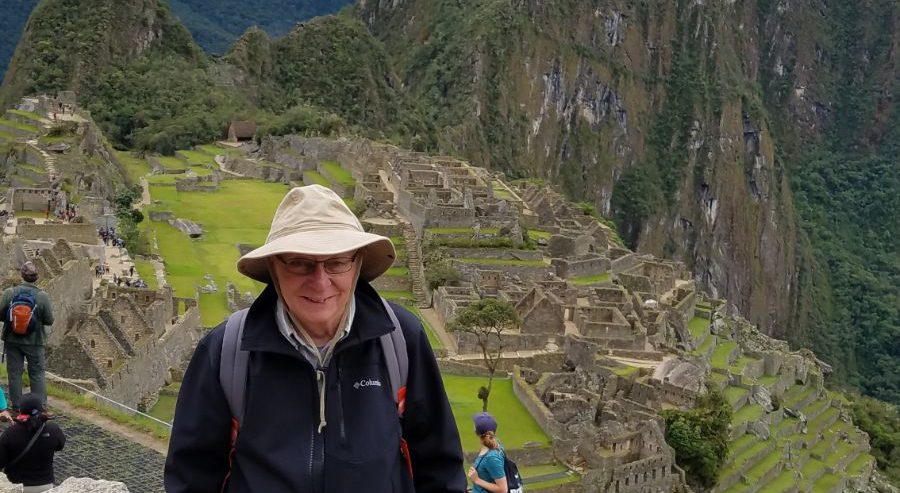The son of an Italian immigrant, Ray Bianchini traces his wanderlust to the two years he spent in Italy in his early 20s serving with the U.S. Navy.
“It took 10 hours to drive from my base in Naples to visit relatives in my father’s village in northern Italy. That’s when I found my passion for travel,” says Ray, now 74. “I just love the diversity and perspectives I encounter.”
Ray became an inveterate traveler, visiting five of the world’s seven continents. But when he learned he had prostate cancer in 2020, he says, “My first thought was: Would cancer end my traveling days?”
Never Miss a Beat!
Subscribe to Our HealthBeat Newsletter!
Thank you for subscribing!
You can now select the specific newsletters you'd like to receive.
You are already subscribed.
Subscribe to more newsletters in our email preference center.
Sorry, an error occurred. Please try again later.
Get Healthy Tips Sent to Your Phone!
A Five-Year Journey
Ray met regularly with his primary care doctor. When blood tests showed Ray’s prostate-specific antigen (PSA) levels were rising in 2017, his doctor referred him to a urologist.
“We started doing regular monitoring every six months,” says Ray, a human services professional who lives in Lower Paxton Township in central Pennsylvania.
When his PSA levels continued to climb, his urologist ordered a prostate MRI in early 2020. In March — a day after the nation shut down for the pandemic — Ray also underwent a biopsy.
Ray received his test results via a telehealth meeting with his doctor.
“Everything stopped when he told me I had prostate cancer,” Ray says. “But, thankfully, it was a low-grade, low-volume cancer. All I had to do was continued monitoring — what doctors call active surveillance.”
Fast forward to June 2022. A routine PSA test and second biopsy showed Ray’s cancer was still low-grade, low-volume — but growing rapidly.
His urologist recommended he begin both radiation and hormone therapy. He received a hormone shot in August and September.
A week before Ray was scheduled to start radiation therapy in December, Nathan Brooks, MD, performed a new outpatient procedure on Ray. Called SpaceOAR™ Hydrogel, the procedure is designed to minimize the potential bowel side effects of radiation therapy by creating a cushion.
Ray, who has irritable bowel syndrome (IBS), appreciated that extra measure.
“Dr. Brooks gave me a few books to read about prostate cancer, and I read them all,” Ray says. “I made it my mission to learn everything I could about prostate cancer before I began treatment. That helped me prepare for therapy, participate in my treatment, and build my confidence in my decisions.”
The Path to Recovery
On Dec. 6, Ray started radiation therapy at UPMC Hillman Cancer Center in Central Pa.
“I’d work each weekday till about 2 p.m., then drive over to UPMC Community Osteopathic campus for my therapy,” says Ray.
In all, Ray received 28 treatments. While many men don’t experience side effects after radiation beyond feeling tired, Ray had some bladder and bowel issues. Those side effects resolved on their own about three months after his treatment ended.
“I can’t say enough good things about the comprehensiveness of the care I received at Hillman Cancer Center,” Ray says. “They’re kind of like family — the good kind! No question was beneath their time. They were there when I needed support but knew when to give me space, too.”
That care and concern extended beyond the doctors and nurses who oversaw his radiation therapy and the technicians who delivered it.
“Here’s just one example: I was walking from my car to the hospital during a wintery mix of snow and rain,” he recalls. “The security guard actually stopped to ask if I wanted a ride! That’s the level of thoughtful care that’s offered.”
Ray also availed himself of some of the nonmedical support services offered by UPMC Hillman Cancer Center.
“I met with a nutritionist to talk about diet and a financial specialist to be sure all the billing would be accurate,” he says.
Ray met with Dr. Brooks a few weeks after his treatment ended.
“The first thing he asked me was, ‘How does it feel to be a prostate cancer survivor?'” Ray says. “I realized I thought I was — but was afraid to say it out loud. I’m really glad he gave me that confidence.”
To get back into traveling, Ray ventured to southeastern New Mexico in late May 2023 to see how he’d do on a short trip.
“I went to Carlsbad Caverns National Park and several other national parks and was very pleased with myself,” he says. “At Carlsbad, I walked the equivalent of climbing to the top of the Empire State Building. Not bad just five months after radiation therapy!”
Ray actually returned to work full-time the day after finishing radiation therapy. His PSA level is now 0.58 — down from a high of 12 before hormone and radiation therapy.
In November 2023, Ray will see the microcontinent of Zealandia when he visits the mountains and fjords of New Zealand. And he’s already booked a trip to the Himalayas for November 2024.
“I tell everyone that if you need cancer care, go to UPMC Hillman Cancer Center,” he says. “I’m proof of the incredible care they provide.”
About UPMC
Headquartered in Pittsburgh, UPMC is a world-renowned health care provider and insurer. We operate 40 hospitals and 800 doctors’ offices and outpatient centers, with locations throughout Pennsylvania, Maryland, New York, West Virginia, and internationally. We employ 4,900 physicians, and we are leaders in clinical care, groundbreaking research, and treatment breakthroughs. U.S. News & World Report consistently ranks UPMC Presbyterian Shadyside as one of the nation’s best hospitals in many specialties and ranks UPMC Children’s Hospital of Pittsburgh on its Honor Roll of America’s Best Children’s Hospitals. We are dedicated to providing Life Changing Medicine to our communities.
